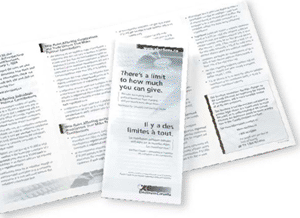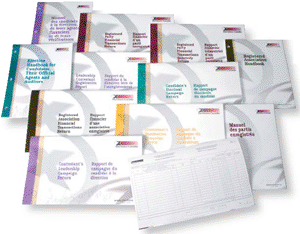Report of the Chief Electoral Officer of Canada
on the 38th General Election Held on June 28, 2004
Political financing
 The Canada Elections Act sets limits on the election expenses of candidates
and registered political parties. Election expenses must be incurred directly
to promote or oppose a registered political party or to elect a particular candidate.
They must be for goods and services used during an election, regardless of when
those goods and services were acquired or paid for. Expenses include money paid,
liabilities incurred, and the commercial value of goods and services donated
or acquired at less than commercial value.
The Canada Elections Act sets limits on the election expenses of candidates
and registered political parties. Election expenses must be incurred directly
to promote or oppose a registered political party or to elect a particular candidate.
They must be for goods and services used during an election, regardless of when
those goods and services were acquired or paid for. Expenses include money paid,
liabilities incurred, and the commercial value of goods and services donated
or acquired at less than commercial value.
Expenses limits
The maximum amount that is allowed for election expenses of a registered party for an election is based on the number of names on the preliminary lists of electors or the number of names on the revised lists of electors (whichever is greater) for the electoral districts in which the registered party has endorsed a candidate. For each electoral district, the limit on election expenses for candidates is determined on the basis of the number of names on the lists of electors or the revised lists of electors, whichever is greater. All candidates in the same electoral district are subject to the same limit. However, the limit varies from one district to another, and it is adjusted for electoral districts with fewer than the average number of electors and for geographically large electoral districts.
On May 28, 2004, the Chief Electoral Officer announced that each registered party would be limited to a maximum of $17,528,373.88 in election expenses if it had a confirmed candidate in each of the 308 electoral districts. The limit for candidates varied among electoral districts, although the average limit was $78,450.52; details of the limits for each electoral district were published at www.elections.ca.
Contributions
An official agent of a candidate who received a contribution, monetary or non-monetary, in excess of $25 had to issue a contribution receipt. After a candidate's nomination was confirmed, and continuing for the rest of the election period, his or her official agent could issue receipts valid for income tax purposes for monetary contributions received. The official agent is entirely responsible for proper use of the receipts valid for income tax purposes under the Income Tax Act. Elections Canada provided software to candidates' official agents with which to produce contribution receipts and official tax receipts.
Reimbursements
All candidates are entitled to a refund of their $1,000 nomination deposit if they comply with the reporting requirements of the Canada Elections Act by submitting the candidate's return within four months after election day and returning all unused receipts for income tax purposes within one month after election day.
A candidate who is elected or receives at least 10 percent of the valid votes cast in his or her electoral district is entitled to a reimbursement of 60 percent of paid election expenses and the candidate's personal expenses paid, to a maximum of 60 percent of the expenses limit in that electoral district.
In addition, the Act provides for a subsidy to cover the candidates' audit fees. This is equal to 3 percent of the election expenses of the candidate, with a maximum of $1,500 and a minimum of $250.
Registered political parties that obtain at least 2 percent of the total valid votes cast in the election, or 5 percent of the valid votes cast in the electoral districts where they endorse candidates, have the right to a reimbursement of 50 percent of their actual election expenses. For the 38th general election only, transitional provisions of Bill C-24 made this amount 60 percent.
Answer to question 3
Originally, no lists were kept of people eligible to vote. Instead, prospective voters identified themselves and swore oaths on presentation at the polls – a system that could easily be abused. In 1853, the Province of Canada adopted a measure calling for the preparation of electoral lists from property assessment rolls, but the idea was abandoned after two years when little progress had been achieved. The requirement to prepare electoral lists was reinstated in 1859 after widespread election fraud. The first election to use the lists was held in 1861.
Recent changes in society and technology have made standing lists the most practical option. In 1996, the National Register of Electors was introduced; Elections Canada has established partnerships with all levels of government to help keep the information up to date. When the 38th general election was called on May 23, 2004, 95 percent of electors were on the preliminary lists of electors.
| Province or territory | Candidates eligible for reimbursement |
|---|---|
| Newfoundland and Labrador | 20 |
| Prince Edward Island | 12 |
| Nova Scotia | 33 |
| New Brunswick | 31 |
| Quebec | 177 |
| Ontario | 302 |
| Manitoba | 40 |
| Saskatchewan | 44 |
| Alberta | 64 |
| British Columbia | 111 |
| Yukon | 3 |
| Northwest Territories | 3 |
| Nunavut | 4 |
| Total | 844 |
| National total of candidates | 1,685 |
| Percent eligible | 50.1 |
Regulation of political entities and training
Registered parties, nomination contestants, candidates, registered associations and leadership contestants can now complete their returns using new software called the Electronic Financial Return. Elections Canada produced videos to inform candidates, nomination contestants and registered associations of the requirements of the Act. The Web site contained downloadable software, along with a user's guide and a tutorial. Also, handbooks and forms were made available on the Web for all political entities. In addition, information sheets posted on the Web site provided information on the financial provisions of the Act.
Candidates' returns
Candidates, through their official agents, must submit audited returns to the Chief Electoral Officer within four months after election day, in this case, by October 28, 2004. Candidates' returns must show all electoral campaign expenses incurred, the amounts and sources of all contributions and transfers, and the names and addresses of those who contributed more than $200.
Following the deadline for submitting these returns, the Chief Electoral Officer will publish a summary of each return on the Web. Returning officers are provided by the Chief Electoral Officer with copies of the candidates' returns, which are made available to the public for six months, so that anyone may consult them or obtain extracts. After that period, the returns may be examined at Elections Canada in Ottawa. The Web site also provides a searchable database of contributions and expenses reported by candidates. This database details the contributions received and election expenses incurred by candidates in all elections since 1997. Information for the 38th general election will be added to this database.
Registered parties' returns
 Following each general election, every registered political party must submit
an audited return of its election expenses to the Chief Electoral Officer. This
is due within six months after election day – in the case of the 38th general
election, by December 28, 2004.
Following each general election, every registered political party must submit
an audited return of its election expenses to the Chief Electoral Officer. This
is due within six months after election day – in the case of the 38th general
election, by December 28, 2004.
Registered parties must also submit an annual fiscal period return, disclosing any by-election expenses, the expenditures of the party during the fiscal period, the amount and source of all contributions and transfers, and the names and addresses of those who contributed more than $200. This return must be submitted to the Chief Electoral Officer within six months after the end of the fiscal period to which the return relates. Along with the audited return of expenses, the registered party must submit a statement of its assets and liabilities, and a statement of its revenues and expenses.
The Chief Electoral Officer publishes the annual financial returns of registered political parties on the Web. The site currently shows their expenses from the last two general elections, and their contributions and expenses by fiscal period from 1993 to 2003.
In addition, commencing in 2005, political parties that were paid a quarterly allowance will have to submit a registered party financial transactions quarterly return, disclosing for each quarter the amount of contribution received during the quarter, the name and address of each contributor that contributed in excess of $200, a statement of the commercial value of goods or services provided and of funds transferred from its registered associations, candidates, leadership contestants or nomination contestants and a statement of contributions received but returned in whole or in part to the contributors or otherwise dealt with in accordance with the Act.
Nomination contests
With the coming into force of Bill C-24, on January 1, 2004, the nomination contests of the registered parties are now regulated. When a contest is held to select a candidate for a registered party, the registered electoral district association or the registered party must submit a report to the Chief Electoral Officer within 30 days after the selection date. By September 24, 2004, Elections Canada had received 836 such reports.
The financial agent for a nomination contestant who has accepted contributions totalling $1,000 or more, or who has incurred total expenses of $1,000 or more for the campaign, must submit a return for the candidate's nomination campaign to the Chief Electoral Officer. This return is due within four months following the selection date. However, if the selection date of the nomination contest falls during an election period for that electoral district, or within the 30 days preceding one, the return may be submitted by the same deadline that applies to the report on the candidate's election campaign. By September 24, 2004, Elections Canada had received 341 reports for nomination campaigns.
